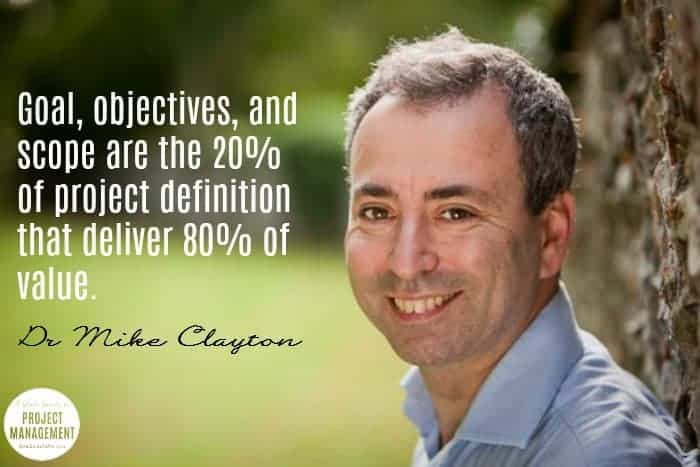The 3 Most Important Things that Define Your Project
This blog is reader-supported. When you purchase something through an affiliate link on this site, I may earn some coffee money. Thanks! Learn more.
This is a guest article by Dr Mike Clayton from OnlinePMCourses.com.
We all know that defining your project well is the foundation of good project management. Without it, you’re managing a mess. Goals, objectives and scope count for a lot. In this article, we’ll discuss how to get those defined.
There’s one thing I’ve learned in training many thousands of project managers. This one topic seems to hold the biggest light-bulb moments.
Because for some people, getting a clear project definition is like sculpting a heap of jelly. That’s jello to my US cousins.
You often have an amorphous set of wants and desires, hopes, dreams and needs. Each subset is championed by a different stakeholder. Each stakeholder has their own style and way of expressing their priorities. And, it gets more complicated still. Your stakeholders have different levels of authority and influence.
And there is one more complicating factor. Terminology.
There’s a lot of
- Definition
- Start-up
- Initiation
- Concept
- Scoping
- Analysis
- Proposal
- …
The 3 things that make a solid project definition
Let’s cut through the clutter.
The core of a solid project definition is three things:
- Goal
- Objectives
- Scope
If you can understand these and can elicit each one clearly from your stakeholders, you’ll be in great shape.
By the way, that’s not always easy. In fact, I consider scoping to be the hardest part of project management. Which is all the more reason to understand it well.

The first problem is goals and objectives
This is a problem, because distinguishing them is not always easy. Indeed, some people talk of ‘goalsandobjectives’ almost as one word.
So let me make it very easy to separate the two ideas.
Goals
A goal is what you want. It answers the first question you should put to your boss, your project sponsor, or your client:
‘What do you want?’
You may also need to consult key stakeholders. When you have achieved a consensus about your project goal is, it’s time to move onto their objectives.
Objectives
Objectives set out what’s important about how you achieve your goal. They articulate what your stakeholders care about, and their criteria for total success. Again, start with your leading stakeholder: your boss, your project sponsor, or your client. Then consult others. Ask them:
‘How do you want the goal delivered?’
Typically, people will answer in terms of the triple constraint of:
- Time – they will have preferred deadlines. They may have required deadlines.
- Cost – they may want you to keep within a certain budget.
- Quality – they may set you specific quality standards to meet.
Again, it’s typical to find that most stakeholders try to tie you down to fixing all three. The common project manager’s refrain is:
‘Time, cost, quality: pick two’
That’s not strictly necessary. As long as the three are consistent, it’s fine in principle. To be OK in practice, you also need to have enough contingency in each of them, to accommodate the level of risk in your project.
As a proxy for risk at this stage, consider a combination of:
- scale
- novelty
- complexity
- priority.
Read next: The Complete Guide to Project Risk Management
Scope
Your project scope sets out the breadth and depth of your ambition for your project. Or, more correctly, your stakeholders’ ambitions.
It answers the question:
‘How much of it do you want?’
There are two approaches to scoping. They depend on whether your project management is rooted in the UK or US. Neither is better, but I guess we all have a preference.
In the US, the scope of your project is the amount and range of products your project will deliver. Once you have defined that, the secondary step is to work out the activities you’ll need, to deliver them.
In the UK, project managers talk of the scope of work for your project. The scope is thus the range of activities the project will encompass. Then, the secondary step is to list the deliverables those activities will produce.
The biggest mistake in scoping a project
Whichever approach you take, there is one further thing you must do. The common mistake is to set out your scope clearly and stop.
What happens then is stakeholders see that scope, interpret the words liberally, and assume they mean more than they do. The phrase you’ll hear is:
‘While you’re doing that, could you just… ?’
You must counter this tendency towards scope creep. If you don’t, it’s a recipe for delay, cost over-runs, errors and defects, and stress. And the way you do it is to look at the boundary around your scope.

Consider every edge case. And then explicitly document what is not included in each scope item. This is your list of project exclusions.
Get your scope exclusions signed-off as part of your full statement of scope, which should also include any project assumptions.
That way, when someone asks: ‘could you just…?’ You can answer:
‘I really wish I could. But I can’t. See here… It’s on the list of things my boss, sponsor, client says are excluded from the project. Sorry.’
There’s more
Of course, there’s lots more to project definition.
On my own website, at OnlinePMCourses.com, you’ll find an extended article. And one of our newest programs is The Project Manager’s Project Definition Kit.
But here’s one thing I’ve learned. Goal, Objectives, and Scope are the 20 per cent of project definition that deliver 80 per cent of value.
These three key elements are about accuracy. Everything else is about precision. Get these three right, and you’ll be hitting the center of your project target. Everything else just clusters your aim more tightly.
About the Author: Dr Mike Clayton is a Project Manager. He has also trained over 6,500 project managers, coached, spoken and written extensively. He has five books on project management with Pearson, Wiley and Macmillan. Mike is the founder of OnlinePMCourses.com, which provides video-based online training for new and mid-level project managers as well as the free PM introductory course Project Management Fundamentals.
Pin for later reading:

